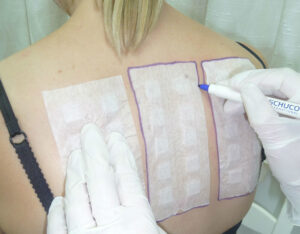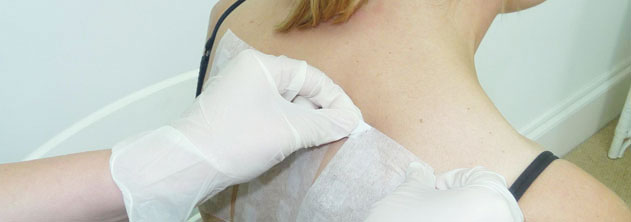Allergy Testing
 Some skin problems are caused by allergies to external factors. In some cases, the allergic reaction comes on immediately and the patient is able to identify very easily what the problem is, e.g. rapid onset of tingling and swelling of the lips and tongue in peanut allergy, which at its most severe can cause a life-threatening allergic reaction (anaphylaxis). In such cases, because the onset of the allergy is rapid, patients can usually identify what they are allergic to. Such immediate allergic reactions (classed as type 1 immune reactions) can sometimes be screened for on blood tests, but are more accurately investigated by prick tests. This involves placing a small amount of the substance suspected to cause the allergy (the allergen) on the skin, and pricking the skin through the allergen. Development of a weal suggests the presence of a type 1 allergy. Although our dermatologist can do prick testing at Dermatology Consulting, we usually refer patients requiring prick testing to a Consultant Immunologist.
Some skin problems are caused by allergies to external factors. In some cases, the allergic reaction comes on immediately and the patient is able to identify very easily what the problem is, e.g. rapid onset of tingling and swelling of the lips and tongue in peanut allergy, which at its most severe can cause a life-threatening allergic reaction (anaphylaxis). In such cases, because the onset of the allergy is rapid, patients can usually identify what they are allergic to. Such immediate allergic reactions (classed as type 1 immune reactions) can sometimes be screened for on blood tests, but are more accurately investigated by prick tests. This involves placing a small amount of the substance suspected to cause the allergy (the allergen) on the skin, and pricking the skin through the allergen. Development of a weal suggests the presence of a type 1 allergy. Although our dermatologist can do prick testing at Dermatology Consulting, we usually refer patients requiring prick testing to a Consultant Immunologist.

Allergic contact dermatitis however, is a more common skin allergy problem, and is a slower allergic reaction to products coming into contact with the skin. After the chemical comes into contact with the skin an itchy, red, eczematous rash occurs between 12 hours and 5 days later (classed as a type 4 immune reaction). This is not a dangerous or life-threatening problem, but can be a source of great inconvenience and distress, particularly when it involves the face. Patch testing can help determine precisely which chemicals the patient has developed an allergic contact dermatitis to.
How is it performed?
Small amounts of several pure chemicals which tend to be the commonest sources of allergic contact dermatitis, are applied under sticky paper patches (usually the back is used). The patches measure approximately 10 cm x 4 cm in diameter and each patch holds ten chemicals. We usually test patients to a basic collection of approximately 38 chemicals which tend to cover most of the contact allergies that British patients tend to develop. However, additional chemicals are available, according to the patient’s circumstances, for example, patch testing is available for chemicals encountered in cosmetic products, hairdressing salons, oils and coolants, footwear, certain plants, and sunscreens. We also suggest that patients bring with them any products they have been using on their skin for example their soap, shampoo, cosmetics or anything else they are concerned they may be allergic to, and we can apply these to the back under additional patches.
The patches are applied to the back, marked with an ink marker pen and then left in place for a couple of days. We usually advise that patients wear an old T-shirt on the day of the patch test application to avoid the ink staining their clothing. The patches are removed approximately 2 days later at home and we ask the patient to have a family member/friend take photographs of the initial appearance of the back when the patches are removed, and bring the photographs to the appointment for the final reading which takes place four or five days after the patches were applied.
From the time the patches are applied until the final reading, it is important that the back is kept dry. An allergic reaction is evident by the development of a small red itchy patch (approximately 1 cm in diameter) at the site where the chemical was applied. Once the precise chemicals that the patient is allergic to are identified, these can be avoided in the future. The itchy red spot settles in a few days without leaving any mark.

